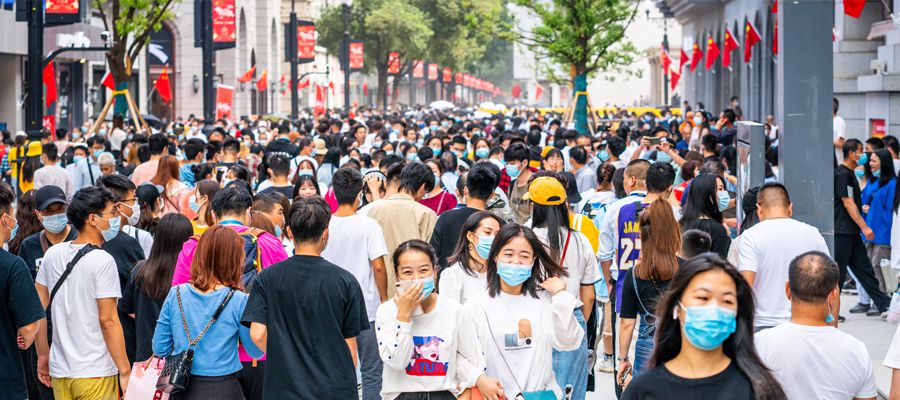The Chinese economy grew 18.3% in the twelve months to March.
- Saturday, May 1, 2021
 The Chinese economy grew 18.3% in the twelve months to the end of March 2021. This is a remarkable recovery from last year. This 18.3% growth comes on top of the news that the Chinese economy fully recovered its GDP to its pre-pandemic levels in 2020. China was the only G20 nation to achieve this.
The Chinese economy grew 18.3% in the twelve months to the end of March 2021. This is a remarkable recovery from last year. This 18.3% growth comes on top of the news that the Chinese economy fully recovered its GDP to its pre-pandemic levels in 2020. China was the only G20 nation to achieve this.
Analysts are however suggesting that the majority of the recovery growth has already been achieved as quarter-on-quarter growth rates are now slowing. The Chinese authorities are already tightening their monetary policy in order to avoid the overheating of their economy.
The famous Chinese consumer has spent 34.2% more in the first three months of this year than the first quarter of 2020 as shops re-opened fully. Industrial output was also up 14.1%. Despite these gains, analysts are now predicting that a number of business sectors will slow as the Chinese authorities reduce their fiscal and monetary support. Industrial activity may not maintain its current growth with the removal of measures that have stimulated the domestic Chinese economy.
Future growth from China however, will be more dependent on export demand as the rest of the world recovers. The US/China trade relations will also have an impact as many developed economies are starting to consider Western supply chains and the sensitivity of procurement particularly in technology.
China has set itself a growth target of 6% for 2021 but interestingly some analysts are forecasting a growth of 7.7% in 2021. But from 2022 GDP is expected to decline to 5.5% as China’s one child policy starts to play out on its aging population, its high levels of national debt and falling productivity growth. The IMF have forecast GDP growth of 8.4% for 2021.
China’s property market bubble is becoming a concern as house prices in the major cities as compared to average incomes are becoming twice the multiple of property in the UK or US. Property is expensive and outside the reach of young couples. Beijing is likely to take steps to rein in borrowing on residential property in order to dampen property prices. This is part of the Chinese authorities tightening of monetary conditions earlier than other nations as they have enjoyed a boom in growth already.
The first in / first out nature of China’s Covid response has enabled them to show impressive early GDP figures but the Chines stock markets such as the Shanghai CSI 300 or Hong Kong Hang Seng have hardly moved over this year suggesting that China’s will be hard pushed to keep growth going.
The economic approach between the West and China seems to have reversed. After the 2008 financial crisis, China implemented an unprecedented policy of stimulus and easing, while the West took a more austere approach. In this post pandemic period, it is the USA that is entering an unprecedented policy of stimulus and easing while China is starting to tighten.
Economists are warning that China is hiding a big unemployment problem. The number of Chinese workers without meaningful employment has shot up to 17%. These predictions are far above the official jobless figure of 5%. Commentators have often voiced their concerns about the accuracy of these official figures. Workers in China’s state-run companies have often been employed to support government statistics but even this seems insufficient now.
With the world wishing to move to a lower carbon footprint, the reliance upon fossil fuels for heating and transport will fall, but the demand for metals needed for electric car batteries and clean energy such as cobalt, lithium, vanadium, tin and copper will only increase. China has a global dominance in the processing of cobalt, nickel and rare earth metals.
For this reason, the West are working to reverse China’s control of these essential metals. For the US and Europe to be successful in the production of batteries for electric vehicles and renewable energy, being self-sufficient in this supply chain will be important.
Access to the companies mining these metals is somewhat limited from an investment point of view. The future mining of rare metals in the southern fiords of Greenland is a good example. About 25% of the world’s rare earth metals are found there. These are the key metals for the development of electric vehicles and wind turbines. The proposed mining by Greenland Minerals which is an Australian company owned by the Chinese is being blocked by local politicians. The supply chain battle is one we can see developing when the needs of the climate, corporate profit and local communities are not aligned.

Chris Davies
Chartered Financial AdviserChris is a Chartered Independent Financial Adviser and leads the investment team.
About Estate Capital
Financial Services
Our Contacts
7 Uplands Crescent,
Swansea, South Wales,
SA2 0PA.
Tel: 01792 477763
